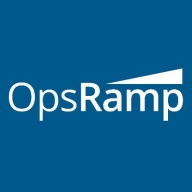

Splunk Observability Cloud and OpsRamp compete in the IT monitoring and management space. Splunk seems to have an edge due to its comprehensive features and excellent data handling capabilities.
Features: Splunk Observability Cloud provides rapid log searching and robust application performance monitoring with tools like dashboards and detectors for effective tracking. Its adaptability to standard components and capability to handle vast data volumes enhances scalability and security. OpsRamp offers strong alert generation, personalized dashboards for infrastructure monitoring, and user-friendly event correlation features.
Room for Improvement: Splunk faces challenges related to high costs, complex deployment, and the need for better log management and automation features. Users desire improved integration support and a more intuitive alerting system. OpsRamp needs to enhance its ITSM platform, improve automation processes, address false alerts, and expand integration capabilities while refining dashboard customization for better usability.
Ease of Deployment and Customer Service: Splunk's detailed documentation is praised, although its deployment can be complex, especially in hybrid and on-premises environments. Customer support reports are mixed, with some noting improvement is needed. OpsRamp focuses on Public Cloud deployments with responsive support, although issues with integration and service response times have been noted. Its deployment simplicity is a benefit, particularly in cloud setups.
Pricing and ROI: Splunk is considered expensive, yet its robust functionality can justify the cost through ROI, notably in insurance and IT sectors. Careful budget management is needed due to its high expense. OpsRamp offers a more affordable option with resource-based bundle licensing, providing pricing flexibility and cost-effectiveness, making it attractive for organizations with comprehensive resource monitoring needs without significant investment.


OpsRamp is a leading cloud-based digital IT operations management platform. The solution allows your organization to leverage hybrid observability, process automation, and machine learning to modernize IT operations. OpsRamp can handle the speed, scope, and scale of modern IT and can help you drive productivity and business value. In addition, it can help your business manage, monitor, and consolidate your point tools and applications.
OpsRamp Features
OpsRamp has many valuable key features. Some of the most useful ones include:
OpsRamp Benefits
There are many benefits to implementing OpsRamp. Some of the biggest advantages the solution offers include:
Splunk Observability Cloud combines log search, data integration, and dashboards for seamless monitoring, enhancing infrastructure visibility and security. Its cloud integration and scalability support diverse environments, improving operational efficiency.
Splunk Observability Cloud offers comprehensive monitoring tools with user-friendly interfaces, enabling end-to-end infrastructure visibility. Its real-time alerting and predictive capabilities enhance security monitoring, while centralized dashboards provide cross-platform visibility. Users benefit from fast data integration and extensive insights into application performance. Despite its advantages, improvements could be made in integration with other tools, data reliability, scalability, and cost management. Users face challenges in configuration complexity and require better automation and endpoint protection features. Enhancing AI integration, alerts, and adaptation for high-throughput services could further improve usability.
What are the key features of Splunk Observability Cloud?In industries like finance and healthcare, Splunk Observability Cloud is implemented for application performance monitoring and infrastructure metrics. Its ability to track incidents and analyze machine data benefits network infrastructure, while distributed tracing and log analysis aid in tackling security threats. Organizations often integrate it for compliance and auditing purposes, enhancing visibility into network traffic and optimizing performance.
We monitor all IT Infrastructure Monitoring reviews to prevent fraudulent reviews and keep review quality high. We do not post reviews by company employees or direct competitors. We validate each review for authenticity via cross-reference with LinkedIn, and personal follow-up with the reviewer when necessary.